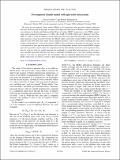Two-impurity Kondo model with spin-orbit interactions
Author(s)
Mross, David Fabian; Johannesson, Henrik
DownloadMross-2009-Two-impurity Kondo.pdf (270.6Kb)
PUBLISHER_POLICY
Publisher Policy
Article is made available in accordance with the publisher's policy and may be subject to US copyright law. Please refer to the publisher's site for terms of use.
Terms of use
Metadata
Show full item recordAbstract
We study the two-impurity Kondo model (TIKM) in two dimensions with spin-orbit coupled conduction electrons. In the first part of the paper we analyze how spin-orbit interactions of Rashba as well as Dresselhaus type influence the Kondo and Ruderman-Kittel-Kasuya-Yoshida (RKKY) interactions in the TIKM, generalizing results obtained by H. Imamura et al. [Phys. Rev. B 69, 121303(R) (2004)] and J. Malecki [J. Stat. Phys. 129, 741 (2007)]. Using our findings we then explore the effect from spin-orbit interactions on the non-Fermi-liquid quantum critical transition between the RKKY-singlet and Kondo-screened RKKY-triplet states. We argue that spin-orbit interactions under certain conditions produce a line of critical points exhibiting the same leading scaling behavior as that of the ordinary TIKM. In the second part of the paper we shift focus and turn to the question of how spin-orbit interactions affect the entanglement between two localized RKKY-coupled spins in the parameter regime where the competition from the direct Kondo interaction can be neglected. Using data for a device with two spinful quantum dots patterned in a gated InAs heterostructure we show that a gate-controlled spin-orbit interaction may drive a maximally entangled state to one with vanishing entanglement or vice versa (as measured by the concurrence). This has important implications for proposals using RKKY interactions for nonlocal control of qubit entanglement in semiconductor heterostructures.
Date issued
2009-10Department
Massachusetts Institute of Technology. Department of PhysicsJournal
Physical Review B
Publisher
American Physical Society
Citation
Mross, David F., and Henrik Johannesson. “Two-impurity Kondo model with spin-orbit interactions.” Physical Review B 80.15 (2009): 155302. © 2009 The American Physical Socie
Version: Final published version